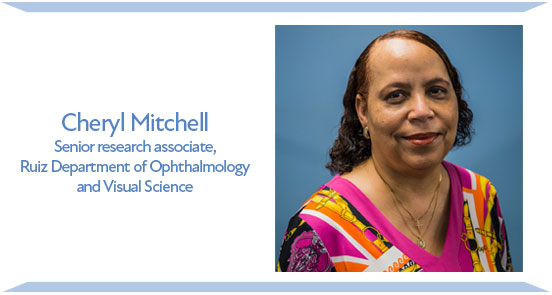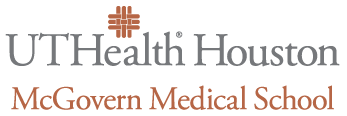January 06, 2021

Editor’s note: Cheryl Mitchell retired Dec. 31, 2020, following a 44-year career with the Medical School.
When did you join UTHealth? What brought you here?
I joined UTHealth in November 1976. I had graduated Baylor University in May 1976 and took the summer off to relax before job searching. I always had an interest in science and come from a family of women with an interest in science. My older sister had done lab research work for a while after graduation before moving on to another path in her science career. I have an identical twin sister who majored in science education. Even my mother dabbled in science as a nuclear medicine technician.
Tell me about your work history here.
I was hired by Dianna A. Redburn, PhD, in the Department of Neurobiology and Anatomy, who I later found out was one of the few women hired by the founding dean of The University of Texas Medical School, Cheves McCord Smythe, MD, for a faulty research position in 1974. She had just been awarded her first RO1 grant from NEI in the summer of 1976 and needed to hire a research technician. Her grant focused on basic science research, the neuroplasticity of vision, and thus I started my lab research career. During the time I worked in her lab, a post-doctoral fellow joined her lab, Steve Massey, PhD, who later would become the director of Basic Science Research in the Department of Ophthalmology, where I now work. Dr. Redburn and her lab became a part of the Department of Ophthalmology in 1994. When Dr. Redburn left UTHealth in 1996, I was hired by Dr. Massey, to manage the Tissue Culture Facility as part of the NEI Vision Core Grant. The Vision Core Grant has four modules, and the Tissue Culture facility is in the Molecular Resources Module of which Dr. John O’Brien is the director and with whom I have worked since 2002. With Dr. O’Brien, I have been allowed to work independently with other faculty members that have NEI RO1 funded research using the facility but also with his NEI RO1 funded research these past 18 years.
What are you most proud of accomplishing?
I don’t know if you describe it as what I am proud of accomplishing, but I always felt a since of pride when grants are funded and manuscripts are published with the research I helped with. I am co-author on over 35 manuscripts and first author on 10 of those manuscripts, with all manuscripts throughout the years resulting in over 690 citations.
How has the university changed since you first joined?
Physically, when I first joined the university, Dr. Redburn’s research lab was located in the Center Pavilion Hospital on the corner of Holcombe and Braeswood. The two-story John Freeman Medical School Building was built. The Medical School building on Fannin Street was partially complete. Dr. Redburn moved into her research labs on the 7th floor in the Medical School Building in 1979. I paid $40 a month for parking in the Herman Professional building (now UTHealth Professional Building). I now I pay $184 a month for parking in TMC Garage 4. I joined the university after the first flood of the Medical School in 1976 and that was a topic everyone was talking about. After the first flood, storm gates were placed in the Medical School receiving, and Bertner Avenue was built up with a hump in the road to control flooding to the building. In 2001, after Tropical Storm Allison, the Medical School flooded once again and was closed for over a month. We were all thankful that after all the improvements and flood doors at the Medical School that when Hurricane Harvey came in 2017 that the anxiety level around the Medical School decreased. There are some things that never change though — I am sure we all worry about flooding at the Medical School every time a heavy rain comes through Houston.
Why have you stayed?
Actually, when Dr. Redburn left the Department of Ophthalmology to go to the University of Tennessee in Memphis, I had made a decision to leave research work and work in the administration side of research, but I found out that doing vision research using cell culture was an area that was a new interest to me because previously I had only worked with animal models. When Dr. John O’Brien joined the Department of Ophthalmology in 1998, it reminded me of working with Dr. Redburn when she was awarded her first NEI RO1 grant. Dr. O’Brien has just written his fifth NEI RO1 research project. I also enjoyed working with and training the graduate students and post-docs that have come through the lab these past 40 years. I have stayed in touch personally with several of them throughout the years, exchanging Christmas cards and emails.
When you are not at work, how do you spend your time?
First, I spend my time with my husband of 42 years, Ronald, a retired electrical engineer with whom I have cruised several times to the Caribbean and Hawaii. We also travel to different vacation spots around the country with our family reunion group. Being a mother of two sons and from a family of seven children, family activities take up a lot of my time. That is the one thing that has been the hardest thing for me during the pandemic is staying home and social distancing.
Secondly, I am active at New Faith Church. I support Ronald with his work in the Love Ministry/Food Pantry and the food give-away drive-by during the pandemic. I teach Adult Sunday School classes and am part of the Intercessory Prayer Ministry, reaching out to church members during their times of need.
Last of all, I am active in Alpha Kappa Alpha Sorority, Inc., the Alpha Kappa Omega Chapter of Houston. I volunteer on various committees focusing on our national programs, working throughout the community with our motto “Service to all Mankind.”
|


